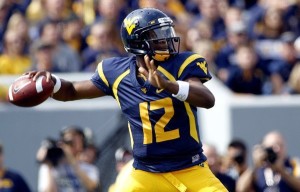by Chase Stuart
on March 17, 2013

Wait, how many USC quarterbacks are starting?
There was a streak in jeopardy in week 17 of the 2012 season. With former Trojan
Carson Palmer injured, the Raiders skipped over his
former USC teammate,
Matt Leinart, and started ex-Ohio State Buckeye
Terrelle Pryor at quarterback for the season finale. Since the Chiefs had previously benched
Matt Cassel for
Brady Quinn, if it wasn’t for
Greg McElroy missing the Jets last game against the Bills — which reinserted
Mark Sanchez into the starting lineup for New York — USC’s streak of consecutive weeks with a starting quarterback in the NFL would have ended. Instead, the streak is now up to 81 weeks with at least one of Sanchez, Palmer, Cassel and/or Leinart starting.
As impressive as that might sound, it’s not even halfway to the record. You can take a second to think about which school had the longest run with at least one of its former players starting at quarterback, but first, another bit of trivia: I noticed that in week 12 of the 2009 season, Matt Leinart, Matt Cassel, Mark Sanchez, and Carson Palmer all started. But believe it or not, that’s not a record, either.
In week 13 of the 2000 season, five quarterbacks from the University of Washington — Warren Moon, Mark Brunell, Damon Huard, Chris Chandler, and Brock Huard — were starting in the NFL. Add in Washington State’s Drew Bledsoe and Ryan Leaf, and seven quarterbacks that played college in the Evergreen State were starting in the NFL that weekend.
[continue reading…]
Tagged as:
Alabama,
Bart Starr,
Carson Palmer,
Joe Namath,
Ken Stabler,
Mark Sanchez,
Matt Barkley,
Matt Cassel,
Matt Leinart,
USC
{ }
by Chase Stuart
on February 26, 2013

The Chiefs play the Baylor game on an endless loop for the other 31 teams.
A few weeks ago, I discovered
cfbstats.com, which has made available for download an incredible amount of college football statistics from the last eight seasons. Thanks to them, I plan to apply some of the same techniques I’ve used on NFL numbers over the years to college statistics. If you’re a fan of college football, you’re probably already reading talented writers like
Bill Connelly and
Brian Fremeau, but hopefully I can bring something new to the table for you to enjoy.
There are many differences between college and professional football, but many of the same stats still matter. For quarterbacks, Adjusted Net Yards per Attempt is still the king of the basic stats , and it is arguably even more important in college where teams play at varying different paces.
There’s a small problem, however, if you want to calculate ANY/A at the college level: the NCAA counts sacks as rush attempts and sack yards lost as negative rushing yards. I manually overrode that decision in my data set, so going forward, all rushing and passing data will include sack data in the preferred manner (keep this in mind when you compare the statistics I present to the “official” ones).
[continue reading…]
Tagged as:
Geno Smith,
Johnny Manziel,
Matt Barkley,
Tyler Bray
{ }


